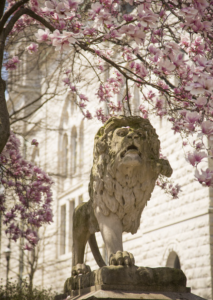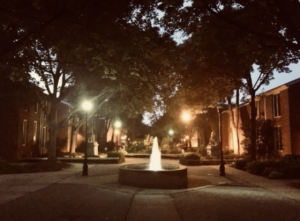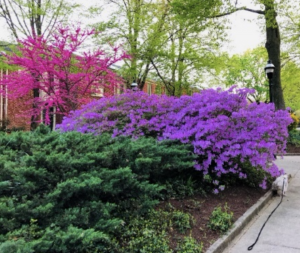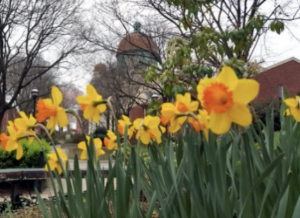
Lion Park was built in 1974 as a “green space” during the construction of The Atrium Association (“The Atrium”). The park is owned by the city but leased to The Atrium under 15-year renewable leases. The Department of Parks and Recreation is responsible for the hardscape while The Atrium is responsible for general maintenance, including landscaping, irrigation and snow removal. The park is open to the public but closed from dusk to dawn.
The Atrium under 15-year renewable leases. The Department of Parks and Recreation is responsible for the hardscape while The Atrium is responsible for general maintenance, including landscaping, irrigation and snow removal. The park is open to the public but closed from dusk to dawn.
 The distinguishing features of this tranquil park are its numerous trees, shrubs, various ground covers, three lion statues, two beautiful water fountains and its open space. It is most majestic in the spring, with a multitude of flowering azalea bushes, daffodils, daylilies and tulips. The park is covered with linden and maple trees with its line of vision reaching up to the Francis Scott Key Monument.
The distinguishing features of this tranquil park are its numerous trees, shrubs, various ground covers, three lion statues, two beautiful water fountains and its open space. It is most majestic in the spring, with a multitude of flowering azalea bushes, daffodils, daylilies and tulips. The park is covered with linden and maple trees with its line of vision reaching up to the Francis Scott Key Monument.
The British lions statues are a true delight and an important part of Baltimore’s history. They originally guarded the entrances to the Calvert Street bridge when it was built in 1879. In 1957 they were removed, after a year of rebuilding of the Calvert Street Bridge to tailor the area to the then-new Jones Falls Expressway. At the time, people felt that the Lions didn’t fit in with the new modern landscape.
The city parks department, which was in charge of the monuments, shipped the King of Beasts to the Baltimore Zoo where they were to be displayed at the entrance to a newly planned lion enclosure. The director of the zoo took the statues but, having no place to display them at that time, stored them in a barn in Druid Hill Park. Seventeen years later, the lions remained in storage. One of the early residents of The Atrium knew about the lions and requested that the city display them in newly developed Lanvale Street Park — now known as Lion Park)

No one knows what happened to the missing fourth Lion, as only three remained in the barn.
The lions had a long history of suffering vandalism. One night in 1893, a tipsy Irishman named Larry Finnegan broke off the tails with a hatchet because he felt that the lions looked too English. He said he could not stand the British. While stored at the zoo, vandals maimed all four lions, breaking off legs and smashing in their faces. If you look closely, you can see evidence of the repair work. Today, the lion statues are safely displayed in Lion Park, and they welcome visitors. The park is accessible from Lanvale Street, Eutaw Place and West Lafayette Avenue through Linden Green townhouses.
-Lee Tawney
